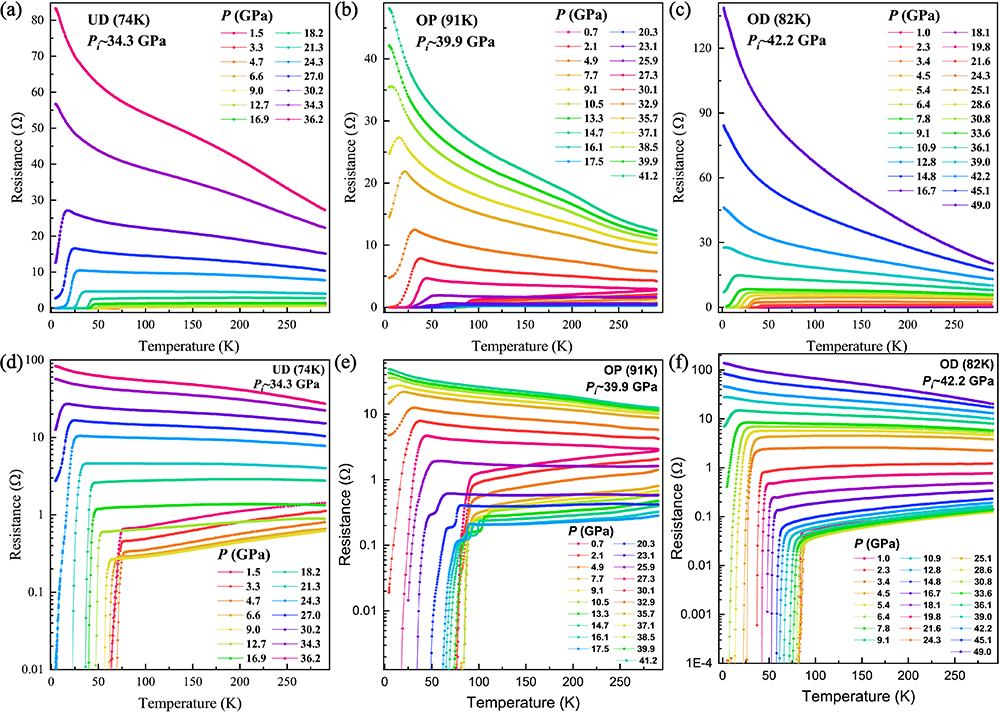Science and technology were considerably impacted by the discovery of cuprate high-temperature superconductors in 1986 and remains fascinating to the communities of condensed matter physics and material sciences as they host unusual electronic behavior and the greatest ambient-pressure superconducting transition temperature.
 Temperature dependence of in-plane resistance for Bi2Sr2CaCu2O8+δ at different pressures. (a) and (d) are the plots of temperature versus resistance with linear and log scales for the under-doped superconductor; (b) and (e) for the optimally-doped sample, the two-step superconducting transition demonstrates a crossover from two-dimensional to three-dimensional superconducting phases in the pressure range of 4.9- 23.1 GPa, in good agreements with our previous studies; (c) and (f) for the over-doped (OD) sample. Image Credit: Institute of Physics.
Temperature dependence of in-plane resistance for Bi2Sr2CaCu2O8+δ at different pressures. (a) and (d) are the plots of temperature versus resistance with linear and log scales for the under-doped superconductor; (b) and (e) for the optimally-doped sample, the two-step superconducting transition demonstrates a crossover from two-dimensional to three-dimensional superconducting phases in the pressure range of 4.9- 23.1 GPa, in good agreements with our previous studies; (c) and (f) for the over-doped (OD) sample. Image Credit: Institute of Physics.
Nevertheless, the supporting mechanism of superconductivity is still a mystery. Looking for the universal links between the superconducting state and its adjoining quantum states is regarded as a functional approach to explain the high-temperature superconducting process.
Prof. Liling Sun’s team from the Institute of Physics (IOP) of the Chinese Academy of Sciences, in collaboration with Profs. Tao Xiang, Xingjiang Zhou and Jiangping Hu from IOP, Prof. Genda Gu from the Brookhaven National Laboratory, and Prof. Chengtian Lin from the Max Planck Institute carried out the study.
The researchers discovered the transition of pressure-induced quantum from a state of superconductivity to a state like insulation in bismuth-based cuprate superconductors, via their advanced in-situ high-pressure measurements.
These experimental findings show that the observed transition of quantum phase is universal in the bismuth-bearing cuprate superconductors, irrespective of the doping level and the quantity of copper oxide (CuO2) planes present in a unit cell.
It is a great surprise for the researchers to know that the system arrives into an insulating-like state once the superconductivity is completely suppressed. As it is well known that the ground state of the over-hole-doped non-superconducting cuprate is metallic, it is unreasonable to expect that the bandwidth to be improved by exerting pressure.
As a consequence, the system needs to become more metallic, rather like insulation. This universal quantum transition discovery provides a new challenge and opportunity for better comprehension of the superconductivity mechanism in these materials.
This study has been published in the journal Nature Physics.
The research was funded by the National Science Foundation of China, the Ministry of Science and Technology of China, and the Chinese Academy of Sciences.
Journal Reference:
Zhou, Y., et al (2022) Quantum phase transition from superconducting to insulating-like state in a pressurized cuprate superconductor. Nature Physics. doi.org/10.1038/s41567-022-01513-2.